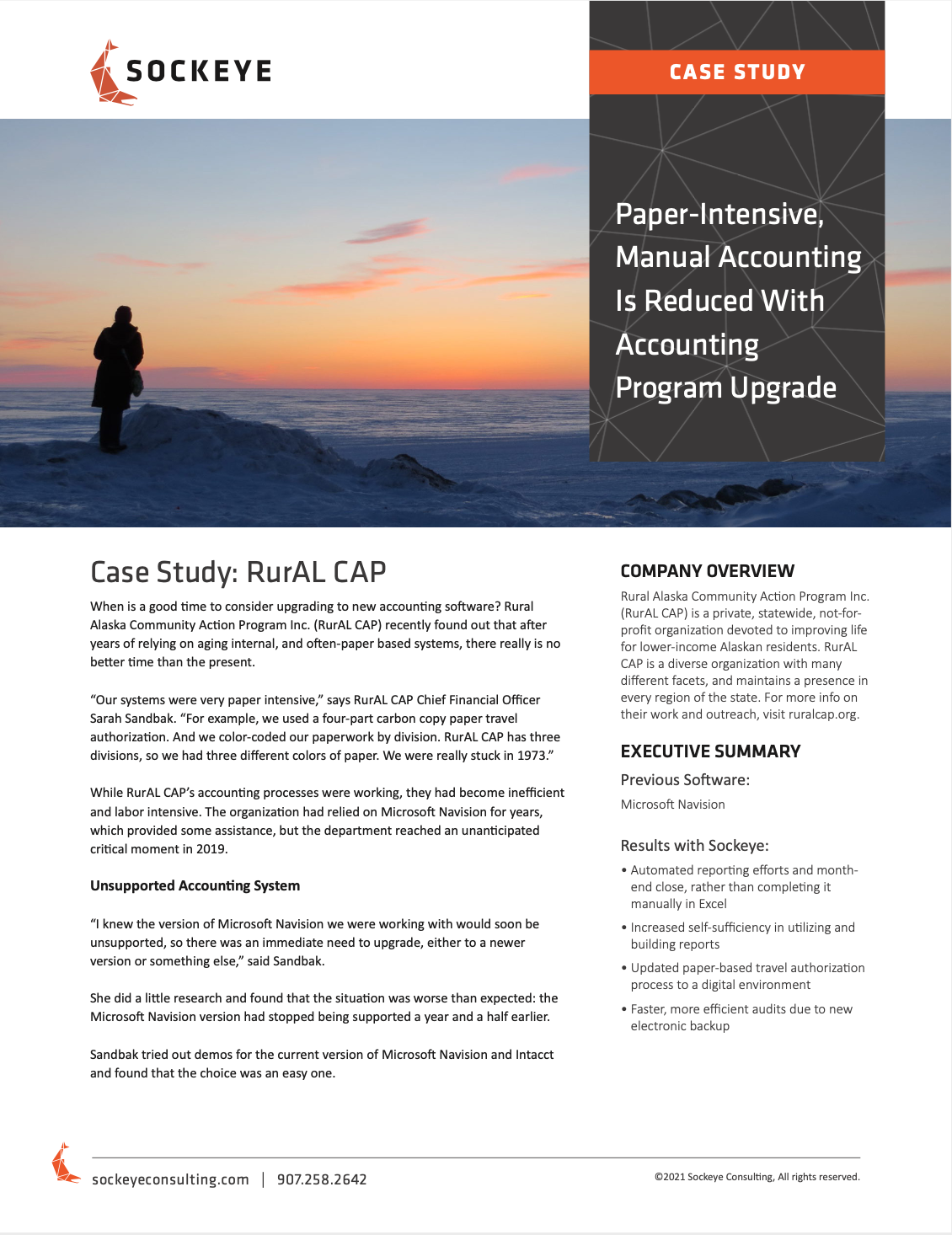SAGE INTACCT CASE STUDY
Paper-intensive, manual accounting is reduced with accounting program upgrade to Sage Intacct

Sage Intacct Case Study: RurAL CAP
When is a good time to consider upgrading to new accounting software? Rural Alaska Community Action Program Inc. (RurAL CAP) recently found out that after years of relying on aging internal, and often-paper based systems, there really is no better time than the present.
“Our systems were very paper intensive,” says RurAL CAP Chief Financial Officer Sarah Sandbak. “For example, we used a four-part carbon copy paper travel authorization. And we color-coded our paperwork by division. RurAL CAP has three divisions, so we had three different colors of paper. We were really stuck in 1973.”
While RurAL CAP’s accounting processes were working, they had become inefficient and labor intensive. The organization had relied on Microsoft Navision for years, which provided some assistance, but the department reached an unanticipated critical moment in 2019.
Unsupported Accounting System
“I knew the version of Microsoft Navision we were working with would soon be unsupported, so there was an immediate need to upgrade, either to a newer version or something else,” said Sandbak.
She did a little research and found that the situation was worse than expected: the Microsoft Navision version had stopped being supported a year and a half earlier.
Sandbak tried out demos for the current version of Microsoft Navision and Intacct and found that the choice was an easy one.
“While the demo was for the current version of Microsoft Navision, it was essentially the same as what we had,” she said. “We would still have to maintain our paper processes and dump our data into Excel to do our reporting. There really wasn’t any big improvement over what we had.”
That made the difference between Microsoft Navision and Sage Intacct even more clear.
“It was absolutely night and day, there was no question about which program we would select. Intacct was very much what we were looking for, and really, what we needed.”
Sarah Sandbak, CFO of RurAL CAP
Delays with travel authorizations were indicative of systemwide issues
Eliminating the four-part, carbon-copy travel authorization paperwork was at the top of the Sockeye team’s priority list.
“This wasn’t a ‘nice-to-have’ for them,” says Esther Goodstein, Sockeye’s NFP Division Manager. “It was something they desperately needed. They needed to really switch gears and find better ways to become more agile, more quickly.”
In addition to the cumbersome paperwork and processing involved, the paper-based travel authorization had to move through a chain of people. “It would literally sit in people’s inbox trays, and we’d have to not only track the paperwork down, but also the people that needed to approve it,” says Sandbak. “And then once it moved through the system and got approval, we’d have to again track down the two people that needed to sign the checks.”
The Sockeye team was able to build out a workflow for RurAL CAP to use. This workflow included the creation of a purchasing workflow that includes steps for approval to travel, generating a payment for a travel advance, and final travel expense reimbursement upon completion of the trip.
Sandbak says that not only is her organization now able to digitally track where the travel authorization is in the workflow, the signature process has been replaced by an online approval process. Any check in excess of $3,000 still requires the dual approval, but it’s a process that now virtually happens in seconds.
“Once those people check the approval boxes online, their signatures are automatically added,” she says.
As a nonprofit, RurAL CAP generates a large amount of data that needs to be managed and reported efficiently.
Founded in 1965, RurAL CAP has remained focused on serving the needs of Alaska’s low-income population. It’s focus has evolved and expanded over time, and now is primarily concerned with three distinct areas: Early Education, Housing, and Health and Well Being.
The not-for-profit receives funding from a variety of sources and entities, all with different reporting requirements. This level of detail and flavor of information is really at a much more complex level than what is typically found with Sockeye’s non-profit customers.
Despite the existing internal inefficiencies, RurAL CAP was able to comply with those reporting needs, which resulted in a significant amount of data being recorded and tracked each month. Data was entered into Microsoft Navision, and then extracted and uploaded into Excel sheets for reporting. The monthly close was tedious and manual, taking far longer than it needed to.
Among the organization’s biggest wins was the ability to automate a significant amount of their reporting, gaining a greater degree of self-sufficiency in utilizing and building reports.

The switch to Intacct not only streamlined the accounting processes, but also how their time is internally allocated.
In addition to improving their ability to meet external reporting requirements, RurAL CAP was also able to automate parts of their month-end close that were previously manually completed, including matching grant revenues to expenses and calculating grant indirect costs and posting them in the system.
The automation has also significantly cut down on the sheer amount of paperwork that used to drive the organization’s accounting processes.
In addition to improving their ability to meet external reporting requirements, RurAL CAP was also able to automate parts of their month-end close that were previously manually completed, including matching grant revenues to expenses and calculating grant indirect costs and posting them in the system.
The automation has also significantly cut down on the sheer amount of paperwork that used to drive the organization’s accounting processes.
“We’ll never be completely paperless, and that’s okay,” says Sandbak. “But we have an accounting tech who used to spend all of her time filing and chasing people down so we could cut checks."
Both were necessary tasks under the old system.
“Now, she no longer does all that filing, and she’s become our payroll backup person, along with learning our receivables process,” she says. “She’s become an incredible resource for our payroll person, who can now actually take vacation and we have someone who can fill in for her.”
With the new accounting platform in place, RurAL CAP has a roadmap for the future.
Sandbak says RurAL CAP is very pleased with the new accounting system and, with more than a year of use, it’s efficiently serving the organization’s needs.
“For us, Sockeye hasn’t just implemented new software,” she says. “It’s really been a true partnership working with them. We don’t sit here and wonder what this button does or if that button will accidentally crash the system.”
Sandbak says that one of the things she continues to appreciate is how easy it is to get that kind of information now that the system is in place and working.
“We know that if we ask a question, we’ll get a response,” she says. “I really like the fact that we can talk with the people who built our system, and who know its foibles. We have a monthly check-in meeting, too, and that helps us get the answers to questions that would typically become lost as they come up. That’s really helped us move this forward.”
More importantly, now that the organization has an efficient and working accounting system in place, it’s helping Sandbak and her team plan for the future.
“We’re in a really good spot right now – we can see where we’re doing well and where we’ll eventually need more help,” she says. “We know where we can eventually add or build in a process.”
Working with Sockeye could not have happened at a better time for RurAL CAP
“Not only were we fortunate that Esther had a lot of non-profit experience, but we were also grateful for the timing and how the change to Intacct was implemented,” says Sandbak. “In our situation, it was a pretty big leap, and not just from leaving an unsupported software system and migrating to Sage Intacct.”
RurAL CAP went live on Intacct just prior to the Anchorage Hunker Down order in March 2020 in response to the COVID-19 pandemic. This order, known formally as Emergency Order EO-03, mandated that non-critical businesses shut down and residents stayed home. Because of the type of organization RurAL CAP is, it wasn’t possible to simply shut down and stop providing services to its clients.
“We would have been dead in the water had we not made that switch,” says Sandbak. “I honestly don’t know how we would have continued. If there’s a lesson to be learned, it’s ‘don’t wait for a pandemic’ to do what you really need to do.”
Executive Summary
RuRAL Cap Company Overview
Rural Alaska Community Action Program Inc. (RurAL CAP) is a private, statewide, not-for- profit organization devoted to improving life for lower-income Alaskan residents. RurAL CAP is a diverse organization with many different facets, and maintains a presence in every region of the state. For more info on their work and outreach, visit ruralcap.org.
Previous Software
Microsoft Navision
Results With Sockeye
Increased self-sufficiency in utilizing and building reports
Automated reporting efforts and month-end close, rather than completing it manually in Excel
Updated paper-based travel authorization process to a digital environment
Faster, more efficient audits due to new electronic backup


